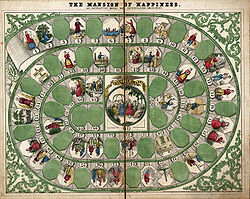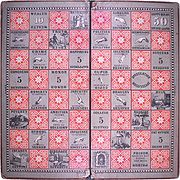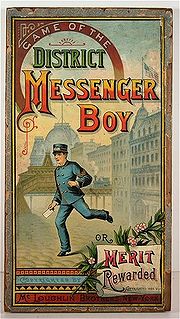
The Mansion of Happiness
Encyclopedia

Board game
A board game is a game which involves counters or pieces being moved on a pre-marked surface or "board", according to a set of rules. Games may be based on pure strategy, chance or a mixture of the two, and usually have a goal which a player aims to achieve...
inspired by Christian
Christianity
Christianity is a monotheistic religion based on the life and teachings of Jesus as presented in canonical gospels and other New Testament writings...
morality. Players race about a sixty-six space spiral track depicting virtues and vices with their goal being The Mansion of Happiness at track's end. Instructions upon virtue spaces advance players toward the goal while those upon vice spaces send them further away from it.
The game was designed by George Fox in England in 1800 where it was published by Laurie and Whittle. The designer's name is mentioned on the game board as well as the English game board Reward Of Virtue. Design of The Mansion Of Happiness has wrongly been attributed to Anne Abbott
Anne Abbott
Anne Wales Abbott or, Abbot was a game designer, magazine editor, literary reviewer, and author. She was born 10 April 1808, the daughter of Reverend Abiel Abbott, a Beverly, Massachusetts clergyman, and Eunice Abbott.Abbott designed the hugely popular card game Dr. Busby, which was published by...
, who designed the famous card game Dr. Busby in 1843 (which sold 15,000 copies in 18 months) and the less popular game Master Roddenbury in 1844, published by W. & S.B. Ives of Salem, Massachusetts
Salem, Massachusetts
Salem is a city in Essex County, Massachusetts, United States. The population was 40,407 at the 2000 census. It and Lawrence are the county seats of Essex County...
. W. & S. B. Ives republished the English game, The Mansion of Happiness in 1843, and it was republished by Parker Brothers
Parker Brothers
Parker Brothers is a toy and game manufacturer and brand. Since 1883, the company has published more than 1,800 games; among their best known products are Monopoly, Cluedo , Sorry, Risk, Trivial Pursuit, Ouija, Aggravation, and Probe...
in 1894 after George S. Parker & Co. bought the rights to the Ives games. The republication claimed The Mansion of Happiness was the first board game published in the United States of America; today, however, the distinction is awarded to Lockwood's Travellers Tour games of 1822. The popularity of The Mansion of Happiness and similar moralistic board games was challenged in the last decades of the 19th century when the focus of games became materialism and competitive capitalistic behavior.
Context

Chromolithography
Chromolithography is a method for making multi-color prints. This type of color printing stemmed from the process of lithography, and it includes all types of lithography that are printed in color. When chromolithography is used to reproduce photographs, the term photochrom is frequently used...
made colorful board games a welcome addition to the parlor tabletop.
One of the earliest children's board games published in America was The Mansion of Happiness (1843), "the progenitor of American board games". Like other children's games that followed in its wake, The Mansion of Happiness was based on the Puritan
Puritan
The Puritans were a significant grouping of English Protestants in the 16th and 17th centuries. Puritanism in this sense was founded by some Marian exiles from the clergy shortly after the accession of Elizabeth I of England in 1558, as an activist movement within the Church of England...
world view that Christian virtue and deeds were assurances of happiness and success in life. Even game mechanics were influenced by the Puritan view. A spinner or a top-like teetotum
Teetotum
A teetotum is a form of gambling spinning top. It has a polygonal body marked with letters or numbers, which indicate the result of each spin. In its earliest form the body was square , marked on the four sides by the letters A A teetotum (or T-totum) is a form of gambling spinning top. It has a...
, for instance, was utilized in children's board games rather than dice, which were then associated with Satan and gambling. While the Puritan
Puritan
The Puritans were a significant grouping of English Protestants in the 16th and 17th centuries. Puritanism in this sense was founded by some Marian exiles from the clergy shortly after the accession of Elizabeth I of England in 1558, as an activist movement within the Church of England...
view forbade game playing on the Sabbath, The Mansion of Happiness and similar games with high moral content would have been permitted children in more liberal households.
In 1860, Milton Bradley
Milton Bradley
Milton Bradley , an American game pioneer, was credited by many with launching the board game industry in North America with Milton Bradley Company....
developed a radically different concept of success in The Checkered Game of Life, the first American board game rewarding players for worldly ventures such as attending college, being elected to Congress, and getting rich. Virtue became a means to an end rather than an end in itself. Daily life was the focus of the game with secular virtues such as thrift, ambition, and neatness receiving more emphasis than religious virtues. Indeed, the only suggestion of religion in Bradley's game was the marriage altar. The Checkered Game of Life was wildly popular, selling 40,000 copies in its first year.
Protestant America gradually began viewing the accumulation of material goods and the cultivation of wealth as signs of God's blessing, and, with the decade of economic expansion and optimism in the 1880s, wealth became the defining characteristic of American success. Protestant values shifted from virtuous Christian living to values based on materialism and competitive, capitalist behavior. Being a good Christian and a successful capitalist were not incompatible. Dice lost their taint during the period, and replaced teetotums in games.

Horatio Alger, Jr.
Horatio Alger, Jr. was a prolific 19th-century American author, best known for his many formulaic juvenile novels about impoverished boys and their rise from humble backgrounds to lives of middle-class security and comfort through hard work, determination, courage, and honesty...
rags to riches
Rags to riches
Rags to Riches refers to any situation in which a person rises from poverty to wealth, or sometimes from obscurity to fame. This is a common archetype in literature and popular culture ....
theme. Games such as Game of the District Messenger Boy, or Merit Rewarded, Messenger Boy, Game of the Telegraph Boy, and The Office Boy allowed players to emulate the successful capitalist. Players began these games as company underlings, newbies, or gofers, and, with luck, won the game with a seat in the President's Office (rather than a seat in Heaven, as in The Mansion of Happiness) or as Head of the Firm. In Parker Brothers' The Office Boy, spaces designated carelessness, inattentiveness, and dishonesty sent the player back on the track while spaces designated capability, earnestness, and honesty advanced him toward the goal. Such games reflected the belief that the enterprising American - regardless of his background, humble or privileged - would be rewarded under the American capitalist system, and insinuated that success was equated with increased social status via the accumulation of wealth.
Wealth and goods became game rewards during the last decades of the 19th century with the winner of McLoughlin Brothers
McLoughlin Brothers
McLoughlin Bros., Inc. was a New York publishing firm active between 1828 and 1920. The company was a pioneer in color printing technologies in children's books. The company specialized in retellings or bowdlerizations of classic stories for children. The artistic and commercial roots of the...
' The Game of Playing Department Store, for instance, being the player who carefully spent his money accumulating the most goods in a department store. Bulls and Bears: The Great Wall St. Game promised players they would feel like "speculators, bankers, and brokers", and the 1885 catalog advertisement for McLoughlin Brothers Monopolist informed the interested, "On this board the great struggle between Capital and Labor can be fought out to the satisfaction of all parties, and, if the players are successful, they can break the Monopolist and become Monopolists themselves".
Game play

Heaven
Heaven, the Heavens or Seven Heavens, is a common religious cosmological or metaphysical term for the physical or transcendent place from which heavenly beings originate, are enthroned or inhabit...
). Centrally located on the board, the goal pictures happy men and women making music and dancing before a house and garden. To reach The Mansion of Happiness, the player spins a teetotum and races around a sixty-six space spiral track depicting various virtues and vices.
Instructions upon spaces depicting virtues move the player closer to The Mansion of Happiness while spaces depicting vices send the player back to the pillory
Pillory
The pillory was a device made of a wooden or metal framework erected on a post, with holes for securing the head and hands, formerly used for punishment by public humiliation and often further physical abuse, sometimes lethal...
, the House of Correction, or prison, and thus, further from The Mansion of Happiness. Sabbath-breakers are sent to the whipping post. The vice of Pride sends a player back to Humility, and the vice of Idleness to Poverty. The game's rules noted:
Design and publication
The Mansion of Happiness was not designed but may have been slightly reworked from the original 1800 English game in 1843 by Anne Wales AbbottAnne Abbott
Anne Wales Abbott or, Abbot was a game designer, magazine editor, literary reviewer, and author. She was born 10 April 1808, the daughter of Reverend Abiel Abbott, a Beverly, Massachusetts clergyman, and Eunice Abbott.Abbott designed the hugely popular card game Dr. Busby, which was published by...
(1808–1908), the daughter of a Beverly, Massachusetts
Beverly, Massachusetts
Beverly is a city in Essex County, Massachusetts, United States. The population was 39,343 on , which differs by no more than several hundred from the 39,862 obtained in the 2000 census. A resort, residential and manufacturing community on the North Shore, Beverly includes Beverly Farms and Prides...
clergyman. Abbott was the author of moralistic fiction for children including Lost Wheelbarrow and Other Stories, and Kate and Lizzie, or Six Months Out of School. She was literary reviewer for the North American Review
North American Review
The North American Review was the first literary magazine in the United States. Founded in Boston in 1815 by journalist Nathan Hale and others, it was published continuously until 1940, when publication was suspended due to J. H. Smyth, who had purchased the magazine, being unmasked as a Japanese...
(she reviewed Hawthorne
Nathaniel Hawthorne
Nathaniel Hawthorne was an American novelist and short story writer.Nathaniel Hawthorne was born in 1804 in the city of Salem, Massachusetts to Nathaniel Hathorne and the former Elizabeth Clarke Manning. His ancestors include John Hathorne, a judge during the Salem Witch Trials...
's The Scarlet Letter
The Scarlet Letter
The Scarlet Letter is an 1850 romantic work of fiction in a historical setting, written by Nathaniel Hawthorne. It is considered to be his magnum opus. Set in 17th-century Puritan Boston during the years 1642 to 1649, it tells the story of Hester Prynne, who conceives a daughter through an...
), and served gratuitously as editor of The Child's Friend, a young people's literary journal whose mission it was "to cultivate a pure and high moral taste". More importantly, she designed popular card games, Master Roddenbury in 1844 and more important: Dr. Busby, first published in March 1843 according to advertisements in the Salem newspapers. Dr. Busby caused the popularity of games in America to explode the same way Monopoly did just after the depression. Remember, slaves and the working poor could not afford the $.50 price of the game which was listed in both the Salem Gazette and Salem Observer in Christmas 1843. Since in 1843 there were less than 2.5 million people in the United Stales and from this we must deduct slaves, working poor, and hand-to-mouth farmers. the United States sale of 50,000 games in less than two years is about the same percentage of buyers to population as Monopoly had when first published in the 1900's. Dr. Busby's sales helped propel sales of Ives' The Mansion of Happiness to 5000 in two years. The image of the game posted at the top of the article is the third printing as denoted by its lithographer Chandler. The first two printings were handled by Thayer & co. out of Boston who were out of business by 1847. The original Laurie & Whittle game was printed using a gold colored ink and octagonal center space and Ives attempted to duplicate this in the first Thayer print run. In the second Thayer print run, circa 1844, the main color of the board was changed to green but the center space was still octagonal. Like most American games of the middle 19th century, The Mansion of Happiness was almost an exact duplicate of the imported English model with its direct prototype being the New Moral and Entertaining Game of The Mansion of Happiness published in 1800 by Laurie and Whittle of London. Laurie and Whittle's game was, in its turn, similar to, but not exactly the same as the Italian The Game of the Goose
Game of the Goose
The Game Of The Goose is a board game with uncertain origins. Some people connect the game with the Phaistos Disc , others claim that it was originally a gift from Francesco I de' Medici of Florence to King Philip II of Spain sometime between 1574 and 1587, while the latest theories attribute to...
, registered in Stationer's Hall in London in 1597.
The Mansion of Happiness was published the year of its redesign by W. & S.B. Ives of Salem, Massachusetts
Salem, Massachusetts
Salem is a city in Essex County, Massachusetts, United States. The population was 40,407 at the 2000 census. It and Lawrence are the county seats of Essex County...
. When the last of the Ives brothers died in 1888, board game titans Charles and George Parker
Parker Brothers
Parker Brothers is a toy and game manufacturer and brand. Since 1883, the company has published more than 1,800 games; among their best known products are Monopoly, Cluedo , Sorry, Risk, Trivial Pursuit, Ouija, Aggravation, and Probe...
purchased the rights to The Mansion of Happiness. In 1894, Parker Brothers republished The Mansion of Happiness as closely as possible to the game's original format with board illustrations hand-colored by an assembly line of women wielding paint pots and brushes. The game remained in the Parker Brothers catalog for thirty years, displaying the line, "The first board game ever published in America" on its box cover. The distinction of "the first" however is awarded today to Traveller's Tour of the United States and Traveller's Tour of Europe published by New York book sellers F. & R. Lockwood in 1822.
Legacy
In spite of America's fascination with wealth and goods in the last decades of the 19th century, didactic Christian games held sway then and well into the twentieth. Even as late as 1893, for example, McLoughlin Brothers released The New Pilgrim's Progress, an upgrade of its 1875 publication based on John BunyanJohn Bunyan
John Bunyan was an English Christian writer and preacher, famous for writing The Pilgrim's Progress. Though he was a Reformed Baptist, in the Church of England he is remembered with a Lesser Festival on 30 August, and on the liturgical calendar of the Episcopal Church on 29 August.-Life:In 1628,...
's moralistic Christian classic, The Pilgrim's Progress
The Pilgrim's Progress
The Pilgrim's Progress from This World to That Which Is to Come is a Christian allegory written by John Bunyan and published in February, 1678. It is regarded as one of the most significant works of religious English literature, has been translated into more than 200 languages, and has never been...
. Similar to its predecessor, the new edition of the game saw players racing about a track from the City of Destruction to The Celestial City with way-stops at The Slough of Despair, Vanity Fair, and Beulah Land.
The affluence of the last decades of the 19th century generated America's first board games based on the idea that happiness and success were not incompatible with the accumulation of wealth through competitive, capitalistic behavior and culminated in 1935 with the publication of Monopoly
Monopoly (game)
Marvin Gardens, the leading yellow property on the board shown, is actually a misspelling of the original location name, Marven Gardens. The misspelling was said to be introduced by Charles Todd and passed on when his home-made Monopoly board was copied by Charles Darrow and thence to Parker...
, the most commercially successful board game in United States history.


